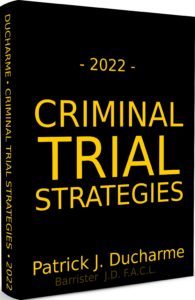What should be said to the jury in opening addresses? From experience, the answer is simple. Counsel should stand before the jury, look at each one of them, and tell them what you expect the evidence will be.
Generally, counsel should avoid using the names of witnesses, since their names at this stage, will be meaningless to the jury. You may make an exception for a vital, pivotal witness whose name deserves to be mentioned because of the importance of that particular witness’s testimony.
An effective technique may be to characterize the witnesses in this matter: “You will hear from three civilian witnesses who will describe the scene; you will hear from two police officers who preserved the scene with photographs and diagrams, and, you will hear from an expert in the field of pathology who will provide his opinion on the manner of death.” The overall effect should be that the opening statement is concise, structured and logical. It should address the vital issues that will confront the jury in their final decision. But it should eschew any argument. The time for argument is during closing addresses.
Generally the prosecutor “opens” to the jury immediately after the Judge’s opening remarks to them. Opening addresses are only permitted so that the jury may have “an outline” of the evidence that will be called. It is improper to make argument during an opening address. The opening remarks are intended to help the jury follow the evidence because it is difficult sometimes to follow the evidence from witness to witness without an overview.
The opening statement may be quite brief. Consider this opening statement which was given by the prosecution at the outset of the murder trial of the famous Captain William Kidd at the Old Bailey Courthouse in London, England, on May 8, 1701:
My Lord, and you gentlemen of the jury, this is an indictment of murder. The indictment sets forth: That William Kidd, on the 30th of October, on the high sea, on the coast of Malabar, did assault one William Moore on board a ship called the Adventure, whereof William Kidd was captain, struck him with wooden bucket, hooped with iron, on the side of the head near the right ear, and that of this bruise William Moore died the next day, and so that William Kidd has murdered the same person.’ To this indictment the defendant pleaded not guilty; if we prove him guilty, you must find him so. Our evidence will seek to show that William Kidd was captain of the ship, and that William Moore was under him in the ship, and that without any provocation the accused gave him the blow whereof he died. It will appear to be a most barbarous fact, to murder a man in this manner; for the man gave him no provocation. This William Moore was a gunner in the ship and this William Kidd abused him, and called him a “lousy dog,” and upon a civil answer by Moore the accused took his bucket and knocked him on the head, whereof he died the next day.
Captain Kidd was found guilty of Moore’s murder and sentenced to death by hanging. The sentence was carried out on May 23, 1701, at the execution dock near the Tower of London. It may be that today a court would censor any comments referring to the act as barbarous. Also, counsel’s reference to “provocation” should at least include a comment that the Judge will instruct the jury on provocation. Most counsel go further to advise the jury that if counsel’s reference to the legal term “provocation” differs from the instruction provided to them by the trial Judge later, the jury is required to follow the Judge’s instructions. The most important point is that effective openings may be brief and poignant, yet effective.
Because an opening address requires counsel to “outline” the intended evidence only, this does not mean that the opening cannot interest or intrigue the jury. Indeed, most good opening addresses are characterized by what might be described as an intriguing or interesting hook to capture the imagination and interest of the jury. To determine whether you are interested in purchasing the book for sale you will normally read the captions contained in the jacket of the book. The pithy comments contained there are likely to help you make the determination of whether you have further interest sufficient to make a purchase. An opening address is no different. Just as the comments in the jacket of a book are intended to create interest, so too are the remarks of counsel in opening address.
One very capable prosecutor this writer opposed recently began his opening with this catchy and interest provoking comment:
For most of us a convenience store offers a nearby place to stop and shop. For Mr. Smith [the accused] the convenience store on the corner of College and Campbell provided a place to stop and rob.
In an equally pithy opening address by defence counsel on a charge of criminal negligence causing death, he began this way:
What could be more horrible than the sudden death of your young child? Probably only the sudden death of your young child at the hands of another. Yet the police allege that you are responsible. Mrs. Smith will tell you that this is her disturbing fate as she appears before you today.
In law school you may be permitted to speak in abstractions and generalizations. Not so before a jury. Every word you speak should meaningfully advance the narrative of the interest that you represent. Remember, the most compelling story is the winning story. Do not sacrifice good advocacy on the altar of legalistic process.
The above is the an excerpt of Patrick J Ducharme’s book, Criminal Trial Strategies, available at Amazon or in bulk through MedicaLegal Publishing.
Read or listen to the Preface and Introduction and subscribe to Patrick Ducharme’s Youtube Channel.

